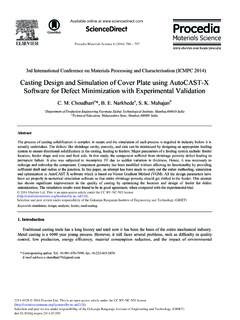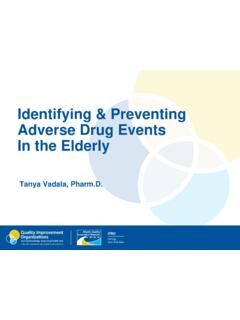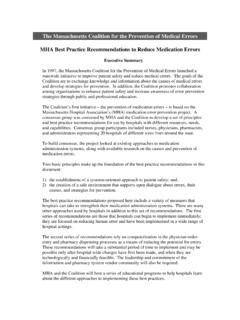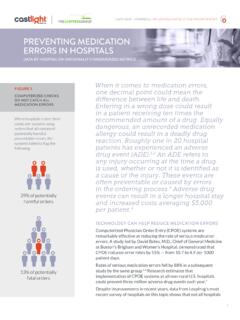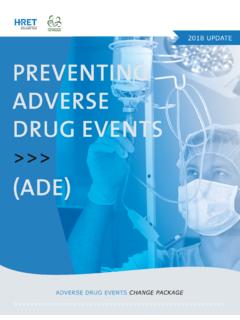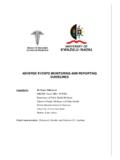Transcription of IDENTIFYING AND PREVENTING ADVERSE DRUG EVENTS IN …
1 See discussions, stats, and author profiles for this publication at: and PREVENTING ADVERSE drug EVENTS in elderly hospitalisedpatients: A randomised trial of a program to reduce ADVERSE drug effectsArticle in The Journal of Nutrition Health and Aging February 2010 DOI: Source: PubMedCITATIONS47 READS1698 authors, including:Thomas CartierIRDES Institut de recherche et documentation en conomie de la sant 10 PUBLICATIONS 500 CITATIONS SEE PROFILEH l ne AgostiniAssistance Publique, H pitaux Universitaires Paris-Sud73 PUBLICATIONS 1,808 CITATIONS SEE PROFILEAll content following this page was uploaded by Thomas Cartier on 08 July user has requested enhancement of the downloaded patients often take a variety of medications to treatmultiple chronic conditions. Suboptimal prescriptions arecommon and problematic in this group (1, 2). First, agingcauses a change in drug metabolism (pharmacokinetics) andtarget organ sensitivity (pharmacodynamics) (3, 4).
2 Generally,the results of these changes in elderly patients are a longer drugactivity, greater or lesser effect of the drug , and an increase inthe incidence of drug toxicity. Because of these changes, thebenefits of medication in elderly patients must be carefullyweighed against the potential associated risks. Second, in thepast decades, there has been a greater tendency to treatsymptoms and increase the number of drugs prescribed toelderly patients, increasing the risk of drug World Health Organization (WHO) defines an adversedrug event (ADE) as a detrimental response to medication thatis undesired and unintended, excluding therapeutic failure,poisoning, and intentional overdose (5). The rate of inappropriate drug use varies from 14% incommunity-dwelling to in nursing home residents (6).Improvement of prescription patterns in medical practice is achallenging task. In practice, all providers and professionals who care forelderly adults play an important role in the process of managingmedications.
3 For example, nurses must identify potentialADEs. drug withdrawal is sometimes necessary in elderlypatients, and although their quality of life may be improved bystopping these drugs, doing it is not always easy forpractitioners. The prevalence of inappropriate prescriptions is particularlyhigh in rehabilitation care settings, where ADEs are alsofrequent. The use of unnecessary, ill adapted or evencontraindicated drugs is the cause of many ADEs. Admission toa rehabilitation care unit, with its consolidation of care,provides an ideal opportunity to review and improve a patient sdrug regimen. It is a good structure for trial discontinuation andmonitoring medications that may not be beneficial. Drugsprescribed for an acute illness may no longer be required oncethe condition is cured or controlled, and many drugs prescribedin the hospital can often be reduced after a few days or therapy may be continued unnecessarily in patients inIDENTIFYING AND PREVENTING ADVERSE drug EVENTS IN ELDERLYHOSPITALISED PATIENTS: A RANDOMISED TRIAL OF A PROGRAM TO REDUCE ADVERSE drug EFFECTSC.
4 TRIVALLE1, T. CARTIER1, C. VERNY2, MATHIEU3, P. DAVRINCHE3, H. AGOSTINI4, L. BECQUEMONT4, P. DEMOLIS5 AND THE IMEPAG GROUP*1. P le Vieillissement, R adaptation et Accompagnement, H pital Paul Brousse, (APHP), 14 avenue Paul Vaillant Couturier, F-94800 Villejuif, France; 2. Service de G riatrie, H pital deBic tre (APHP), 12 rue S verine, F-94276 Le Kremlin Bic tre, France; 3. H pital Corentin Celton (APHP), 4 parvis Corentin-Celton, F-92133 Issy-les-Moulineaux, France; 4. Unit deRecherche Clinique (URC), H pital de Bic tre (APHP), 12 rue S verine, F-94276 Le Kremlin Bic tre, France; 5. AFSSAPS, 143-147, Boulevard Anatole France; F-93285 Saint-DenisCedex, France. Correspondence: Dr Christophe TRIVALLE, Tel : , Fax : , E-mail : Evaluate the impact of educational intervention in decreasing ADEs in elderly patients in ahospital setting. Design: Randomised prospective study. Setting: The study was performed in France in the Parisarea, in 16 rehabilitation geriatric centres of APHP (Assistance Publique H pitaux de Paris).
5 Patient capacityper centre varied from 15 to 57 with a total of 526. Participants:All the patients 65 years hospitalized duringthe 4 week study period were included. Measurements: During a first 2 week phase without intervention ADE swere recorded in all centres. Then units were then randomised for an educational intervention or not. Theeducational phase lasted 1 week, without ADE tracking. Then, both types of units (I+ and I-) recorded ADEs for2 weeks. Possible drug -related incidents were detected using a standardized check list (nurses) and a weeklyreview of all charts by investigators. Possible drug -related incidents were analysed by a group of reviewersselected from the authors to classify them as ADE or not. Results: 576 patients (mean age: years) wereconsecutively included. The mean number of drugs at inclusion was drugs per patient. 223 out of 755events were considered probable ADEs ( ).
6 Among the 223 ADEs, 62 (28%) could have been main outcome of this trial was the change in the proportion of ADEs in elderly patients in the intervention-units, compared to the control group. The main errors were: to high a dose (26%), double therapy (21%), underdose (13%), inappropriate drug (13%), drug - drug interaction (6%), previous same ADVERSE drug reaction (3%) andmiscellaneous ( ). After a specific educational intervention program, there were fewer ADEs in theintervention group (n = 38, 22%) than in the control group (n = 63, 36%; p = ). Conclusion: Educationalprograms could help reduce the prevalence of ADEs by 14% and encourage physicians to change outdatedprescription words: ADVERSE drug event, elderly, Nutr Health AgingTHE JOURNAL OF NUTRITION, HEALTH & AGING TRIVALLE:04 LORD_c 9/09/09 11:28 Page 12J Nutr Health AgingIDENTIFYING AND PREVENTING ADVERSE drug EVENTS IN ELDERLY HOSPITALISED PATIENTS hospital if a competent senior member fails to review theprescription chart, if more than one doctor prescribes for thepatient or if no one questions the duration of the suggests that a thorough evaluation of diagnosticindications for drug treatment in the elderly and/or a reductionof potentially inappropriate drugs may provide significantclinical benefits.
7 However, few data are available on whatpercentage of ADEs may be prevented, and which strategiesmay be used to prevent them (1). Our hypothesis is that aneducational intervention program will be effective in decreasingADEs in elderly patients in hospital settings. MethodsStudy settingsThe study was performed in France, in the Paris area, in 16geriatric centres of the APHP (Assistance Publique H pitauxde Paris). The main activity of these centres was rehabilitationcare in elderly patients. Patient capacity per centre varied from15 to 57 with a total of were recorded during a first phase withoutintervention, including all centres and lasting 2 weeks. Theunits were then randomised to receive educational interventionor not. The educational phase lasted 1 week, without ADEstracking. Then, both types of units (I+ and I-) recorded ADEsfor 2 weeks. The study lasted 5 weeks in all centres (fig. 1)The intervention included a physician and a nurse who bothmade oral and written recommendations to the rehabilitationcare team (physicians, nurses and pharmacists) to adaptprescription habits.
8 The control group didn t receive anyrecommendations about their prescription patterns in drug -related incidents were detected with astandardized check list (nurses) and a weekly review of allcharts by investigators. Nurses and residents were asked toreport incidents to investigators. An investigator visited eachunit on weekdays and obtained information from nurses andresidents. Instructions were also given on how to complete datacollection forms. The investigator reviewed all charts weekly. To discover the causes of preventable EVENTS , the results ofthe investigation were analysed by a multidisciplinary team ofphysicians and pharmacists (CT, CV, AMM, PhD). Possibledrug-related incidents were analysed by a group of reviewersselected among the authors to classify them as ADEs or considered the temporal relation between drugexposure and the event, as well as whether the event reflected aknown effect of the drug .
9 For all EVENTS classified as ADEs,reviewers also determined preventability. Cases included anyone aged 65 or older who experienced anADE during the study period. In individuals with multipleADEs, only the first ADE was included. When there wasdisagreement about the classification of an event, reviewers metand reached a interventionFor one week, I+ rehabilitation care teams received specificinformation about prescribing in the elderly, ADEs, how toprevent them and how to identify them. The teaching staff emphasized the risks associated withseveral classes of medications: nonsteroid anti-inflammatorydrugs, benzodiazepines, and anticholinergic medications. Theseare associated with ADVERSE outcomes when taken by elderlyadults and should be taken with caution. They also discussedthe use of opioid medications in seniors. Although they are notwithout risk, opioids are generally safe with slow titration,precautions, and a bowel regimen to prevent , prescribers were told to consider estimating creatinineclearance when prescribing medications that require doseadjustment due to renal measuresAll patients 65 years hospitalized during the period studywere included.
10 The main outcome of this trial was the changein the proportio n of A DEs in elderly patients in theintervention-units compared to the control of ADEsA sign or symptom caused by one drug or a drugcombination was considered a probable ADVERSE effect if: (i)there was a reasonable temporal sequence from the beginningof the drug combination treatment, (ii) there was a knownresponse pattern, (iii) the signs or symptoms were improved bydiscontinuation of the drugs, (iv) the signs and symptoms couldnot reasonably be explained by the known characteristics of thepatient s clinical condition (7).Preventable ADEsSome ADEs can be considered preventable, for example,excess doses of a drug ; interfering chronic diseases that werenot taken into account; and preventable drug - drug drug - drug interactions were defined based onabsolute or relative contraindicated drug data were taken from the Vidal dictionary (8), whichcorresponds to the Physician's Desk Reference, and is thereference book used for drug prescriptions by Frenchphysicians; it is updated annually by the French analysisData were recorded and analysed using the Statviewstatistical package.





